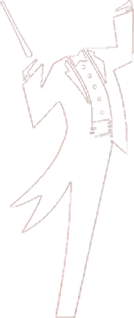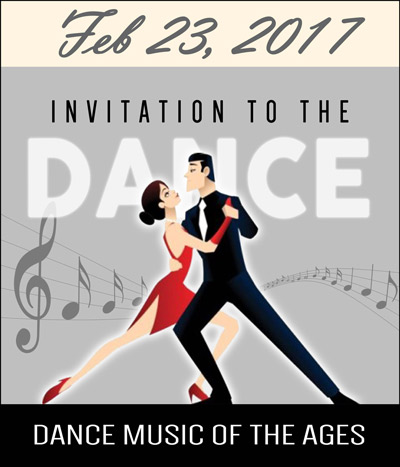Evening’s Performances
Bach: Orchestral Suite BWV 1069 in D Major
Von Weber: “Invitation to the Dance”
J Strauss, Jr: “Tales from the Vienna Woods”
Smetana: Dance of the Comedians
John Adams: Chairman Dances
Faure: Pavane, Op. 50
Copland: Hoedown from “Rodeo”
Rodriguez: La Cumparsita Tango
Concert 4 Invitation to the Dance: Dance Music of the Ages
February 23, 2017 at 7:30 PM
Wine & Cheese Reception 6:30 pm
Cailloux Theater – Kerrville, Texas
To learn more about this concert, see the Conductor Letter and Program Notes below.
Conductor’s Letter
Dear Friends,
You are cordially invited to join us as we celebrate the greatest dance music of the ages at the Symphony of the Hills fourth concert of the season. This concert program was dreamed up by members of our Music Committee in recognition of how much great orchestral music is inspired and influenced by dancing. Composers from J.S. Bach to Johannn Strauss up to John Adams, the famous American composer, will be featured.
Dance music is in many ways, a discreet genre of orchestral music. Like opera, the composers heard on this concert were writing music to accompany the various dance steps, including classics like the Minuet and Bourree of Bach’s orchestral suites. Concert goers will also hear music of the waltz, pavane, hoedown, and ballet.
Not only is dance music beautiful to hear; it is thrilling to watch. We will feature dancers on a couple of tunes, including that most evocative of dances, the tango.
We hope you enjoy this program of dance music from around the globe. As always, thank you for your attendance and support,
Gene Dowdy
Conductor & Artistic Director
Program Notes
Orchestral Suite (No. 3) in D Major
Johann Sebastian Bach (1685 – 1750)
Johann Sebastian Bach is regarded as one of the greatest composers of all time. He is celebrated as the creator of masterpieces of church and instrumental music. Although he was greatly admired during his lifetime as an outstanding harpsichordist, organist, and expert on organ building, his inventive music did not receive broad exposure until the mid-19th century. Bach is now considered by many to be the father of modern Western classical composition and by some Bach enthusiasts to be the “original jazz musician.” Appearing at a propitious moment in the history of music, Bach was able to survey and bring together the principal styles, forms, and national traditions that had developed during preceding generations and, by virtue of his invention and synthesis, enrich them all.
Orchestral Suite No. 3 is one of four such suites by Bach (which he called ouvertures.) The name ouverture refers only in part to the opening movement in the style of the French genre, in which a majestic opening section in relatively slow dotted-note rhythm in duple meter (i.e., marked by two or a multiple of two beats per measure of music) is followed by a fast fugal section, then rounded off with a short recapitulation of the opening music. More broadly, the term ouverture (or overture) was used in Baroque Germany for the opening of a series of dance-pieces in the French tradition. This genre was extremely popular in Germany during Bach’s day, but his interests were elsewhere. As with many other musical genres, Bach’s inventions served as inspiration for others to develop more fully.
Invitation to the Dance
Carl Maria von Weber (1786 – 1826)
Carl Maria Friedrich Ernst von Weber was a German composer, conductor, pianist, guitarist and critic, one of the first significant composers of the Romantic school. Weber’s operas greatly influenced the development of the Romantic opera in Germany and one of his early works, Der Freischutz, came to be regarded as the first German “nationalist” opera.
A brilliant pianist, Weber composed four sonatas, two concertos and the Konzertstück (concert piece) in F Minor, which influenced composers such as Chopin, Liszt and Mendelssohn. His shorter piano pieces, such as the “Invitation to the Dance”, were later orchestrated by Berlioz, and achieved great popularity.
The “Invitation to the Dance” was composed by Weber in 1819, and dedicated to his wife, Caroline; it was (and still is) considered to be the most brilliant example of dance music written at that time. It opens with a slow introduction, the “Invitation,” repeated by various groups of instruments, and leading to the main section of the work, a fascinating waltz theme. A second graceful and languishing theme follows, is fully developed and then followed by a new theme. This leads to the third part, constructed upon phrases from the previous theme. A lively concluding theme is followed, after a pause, by a reprise of the slow introductory. In a biography of Weber, his son relates that while the composer was playing the piano version of the “Invitation” to his wife, he gave her a narrative corresponding to the various musical themes. It describes an elaborate and formal process by which a gentleman invites a lady to dance. The reader is left with the impression that this process of invitation would take as much time to complete as the dance itself.
Fresh, graceful, and spirited, the work is the quintessence of the dance. Riehl says of it: “It marks the transition of modern dance music … Weber was the founder of the dance music expression of deep feeling, and of a school of which Richard Strauss afterwards was an acolyte.” Weber’s orchestration has also been highly praised and emulated by later generations of composers – Berlioz referred to him several times in his Treatise on Instrumentation while Debussy remarked that the sound of the Weber orchestra was obtained through the “scrutiny of the soul of each instrument.”
Tales from the Vienna Woods
Johann Strauss, Jr. (1825 – 1899)
Strauss II was born in Austria to the widely known and respected composer Johann Strauss I. Strauss I wanted his son to be a banker and definitely not a musician; apparently the elder Strauss wanted his son to escape the “rigors of a musician’s life.” In fact Strauss I punished his son when he found him playing the violin, an act that only strengthened the younger man’s resolve to pursue a musical career. Strauss Jr. eventually surpassed his father’s fame, and became one of the most popular waltz composers of the era, extensively touring Austria-Hungary, Poland, and Germany with his orchestra.
Composed in 1868, Tales from the Vienna Woods is one of six Viennese waltzes by Johann Strauss II which features a zither as a solo instrument. The waltz’s premiere that year reiterated the ascendancy that the dance had made from its humble village origins to become one of the pleasures of fashionable Viennese society, thanks to the performing and composing talents of the Strauss family.
This waltz’s introduction is long, 119 bars in the musical score. The first part of the introduction starts off in C major, intertwining with F major before gaining in volume and mood, finishing with a protracted harmony. The second more reflective part is in the key of G major with a solo violin incorporating bits of material that appear again in successive sections. A short flute cadenza invoking a bird’s song comes along, then moving on to the moderato played by zither or string quartet. Loud orchestral chords bring the waltz back to reality, and the familiar waltz theme in F major completes the piece.
“Dance of the Comedians” from the Bartered Bride
Bedřich Smetana (1824 – 1984)
Bedřich Smetana was a Czech composer who pioneered the development of a musical style closely identified with his country’s aspirations to independent statehood. He is thus widely regarded in his homeland as the father of Czech music. Smetana was born in March 1824 as Friedrich Smetana to a musically gifted father in a town east of Prague near the traditional border between Bohemia and Moravia. Smetana was introduced to music by his father and in October 1830, at the age of six, gave his first public piano solo to an enraptured audience.
His works, mainly for the piano, included the three-part Wedding Scenes, some of the music of which was later used in the 3-Act comic opera The Bartered Bride. The “Dance of the Comedians” is a very fast-paced and challenging orchestral piece written by Smetana for Act III of The Bartered Bride, which he continued to refine over several years. Many in our audience this evening will recognize the “Dance of the Comedians” as background for Wile E. Coyote as he compulsively but fruitlessly pursued the Road Runner. [/su_column]
“The Chairman Dances”
John Coolidge Adams (1947 – )
Composer, conductor, and creative thinker, John Adams occupies a celebrated position in the world of American music. His operatic and symphonic works stand out among contemporary classical compositions for their depth and brilliance. Over the past 25 years, Adams’ music has served to turn contemporary music toward an expansive, expressive language, entirely reflective of the environment in which he spent his formative years.
Born and raised in New England, Adams began composing at age 10 and heard his first orchestral pieces performed while still a teenager. He learned the clarinet from his father and played in marching bands and community orchestras as a teen. His studies at Harvard University and attendance at Boston Symphony Orchestra concerts helped shape him as an artist and thinker. Adams’ music is considered an extension of the minimalist movement, built upon repetition and simplicity. The point of minimalism in music is to engage … to use people’s innate preference for familiarity in the creation of something new. The result is often hypnotic.
“The Chairman Dances” is a 1985 composition by Adams, (subtitled “Foxtrot for Orchestra,”) which was composed on commission from the Milwaukee Symphony. It is described by Adams as an “out take” from Act III of the opera he was working on at the time, Nixon in China.
Although the piece incorporates several dance-like tunes, the word “dances” in the title is a verb rather than a plural noun. It is meant to depict Madame Mao gatecrashing a presidential banquet, hanging paper lanterns, and performing a seductive dance. Chairman Mao descends from his portrait, and the two dance a foxtrot together. The piece ends with the sound of a gramophone winding down.
Pavane
Gabriel Urbain Fauré (1845 – 1924)
Gabriel Urbain Fauré was a French composer, organist, pianist and teacher. He was one of the foremost French composers of his generation, and his musical style influenced many 20th-century composers. Among his best-known works are his Pavane, Requiem, nocturnes for piano and the song “Clair de lune”.
Fauré was born into a cultured but not especially musical family. His talent became clear when he was a small boy. At the age of nine, he was sent to a music college in Paris, where he was trained to be a church organist and choirmaster. Among his teachers was Camille Saint-Saëns, who became a lifelong friend. After graduating from the college in 1865, Fauré earned a modest living as an organist and teacher, leaving him little time for composition. When he became successful in his middle age, holding the important posts of church organist and director of the Paris Conservatoire, he still lacked time for composing; he retreated to the countryside in the summer holidays to concentrate on composition. In his later years, Fauré was recognized in France as the leading French composer of his day. An unprecedented national musical tribute was held for him in Paris in 1922, headed by the president of the French Republic. Outside France, Fauré’s music took decades to become widely accepted, except in Britain, where he had many admirers during his lifetime.
The Pavane in F-sharp minor was originally a piano piece, but is better known in the version for orchestra and optional chorus. Obtaining its rhythm from the slow processional Spanish court dance of the same name, the Pavane ebbs and flows from a series of harmonic and melodic climaxes, conjuring a haunting Belle Époque elegance. The piece is scored for a modest orchestral group consisting of string instruments and one pair each of flutes, oboes, clarinets, bassoons, and horns.
“Hoedown” from Rodeo
Aaron Copland (1900 – 1990)
In 1942 Copland composed the ballet Rodeo (originally entitled “The Courting at Burnt Ranch”), a tale of a ranch wedding written about the same time as his Lincoln Portrait. Rodeo is another enduring composition by Copland and contains many recognizable folk tunes well-blended with Copland’s original music. Notable in the final ballet movement is the striking “Hoedown”, a recreation of Appalachian fiddler W. H. Stepp’s version of the tune “Bonypart” (“Bonaparte’s Retreat”), which had been transcribed for piano by Ruth Crawford Seeger. Stepp had transformed the tempo from a march to a hoedown and it made a strong impression on Copland, who subsequently incorporated it note for note in “Hoedown.” This piece is now one of the best-known compositions by any American composer, having been used countless times in movies and on television. It can be added that the Rodeo ballet was choreographed by Agnes de Mille, niece of film giant Cecil B. DeMille. It premiered at the Metropolitan Opera in 1942, with de Mille dancing the principal “cowgirl” role; the performance understandably received a standing ovation.
“La Cumparsita” Tango
Gerardo Rodríguez (1897 – 1948)
Gerardo Hernán Matos Rodríguez was born in Montevideo, Uruguay, the son of the owner of a popular local cabaret. He began his studies in architecture, but did not finish the coursework. Instead, he pursued his overriding interest in music, took up piano and began composing as a young student. His first known composition for the piano, “La Cumparsita”, he wrote as a march in 1916 and played it for a friend in his father’s cabaret. The piece attracted the attention of an orchestra leader in a nearby café, who rewrote it as a tango. The piece quickly became one of the most recognizable tango pieces. Ironically, Matos was initially too shy to play the piece himself, and it became popular only through the widespread performance by others.
In the interim period, this piece has become ubiquitous in popular culture … a global standard for the tango. Gene Kelly danced to “La Cumparsita” in the film Anchors Aweigh (1945), as did Gloria Swanson and William Holden during a ballroom scene in the film Sunset Boulevard (1950.) It appears in the 1959 film Some Like It Hot, in which it is played by a blindfolded Cuban band during a scene in which Jack Lemmon dances while dressed in drag. In 1997 the song was named the national cultural anthem of Uruguay.
Concert Notes by Jim Adams




